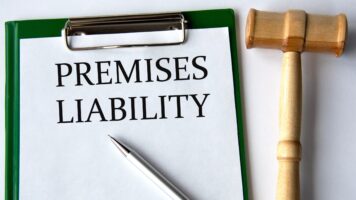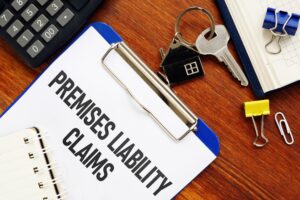Renting a home or apartment can be a great option for many people, but what happens if you get injured on the rental property? Is your landlord responsible for your medical bills and other expenses?
The answer isn’t always clear, but speaking to a Cape Girardeau premises liability attorney about your rights as a tenant and your landlord’s obligations can resolve this situation with you.
When is a Landlord Liable for Tenant Injuries?
Landlords are generally not automatically liable when a tenant gets hurt on their rental property.
However, there are certain situations where a landlord can be held responsible for a tenant’s injuries. The key factor is whether the landlord’s actions (or lack of action) caused or contributed to the injury.
To determine if a landlord was negligent and therefore liable for a tenant’s injuries, insurance companies and courts will consider several factors. Your premises liability lawyer can review these factors and make a liability determination in your case.
Control Over the Dangerous Condition
One crucial factor in determining a landlord’s liability for a tenant’s injury is whether the landlord had control over the dangerous condition that led to the accident.
If the landlord is legally obligated to maintain and repair the area where the injury occurred, they are more likely to be held responsible.
For instance, if a tenant falls on a broken stair in a common area the landlord is supposed to maintain, the landlord can be liable for the tenant’s injuries. The landlord has a duty to ensure that common areas are safe for tenants and their guests.
Knowledge of Hidden Dangers

Landlords must notify tenants about dangerous conditions that are not obvious or hidden, such as an uneven floor or a basement access door under a rug.
If a landlord fails to disclose these hazards and a tenant suffers an injury, the landlord may be held liable. Tenants have a right to be informed about any potential risks in their living space, allowing them to take necessary precautions to avoid injury.
Foreseeability of the Accident
Courts also consider whether a reasonable person may have foreseen that the conditions at the rental property can cause injury. If so, the landlord must take measures to prevent injuries.
For example, if a landlord is aware of a loose handrail in a stairway under their control, they should instruct tenants to use a different flight of stairs until they complete the necessary repairs.
If the landlord fails to do so and a tenant suffers an injury, the landlord may be held liable because the accident was foreseeable and the landlord had a duty to address the issue.
Cost of Reducing Danger
Courts review a landlord’s responsibility for safety. They examine whether a simple, inexpensive step could have prevented harm.
For example, adding a caution stripe to a step can prevent tripping. If the landlord doesn’t do this and a tenant gets hurt, the court might hold the landlord accountable. The reason is the low cost and effort needed to prevent the injury.
Likelihood of Serious Injury
The severity of the potential injury is another factor that courts consider when determining a landlord’s liability. When there is a great risk of serious injury, a court will likely require a landlord to fix the situation as soon as possible, regardless of the difficulty or cost of the repair.
For example, a porch with rotting beams must be removed or replaced. If not, it should be marked “off limits.” The rot makes a collapse likely. That can cause catastrophic injuries.
If a landlord fails to address such a serious hazard and a tenant suffers an injury, the court is more likely to find the landlord liable due to the gravity of the potential harm.
Reasonable Steps to Prevent an Accident
We expect landlords to exercise reasonable care to prevent tenant injuries. This means taking the same care that a normal landlord may use in similar circumstances.
For instance, a landlord who fails to fix a defective step for weeks is probably not making reasonable efforts to deter tenant harm. If a tenant suffers an injury due to the landlord’s failure to address the issue promptly, the court may find the landlord liable for not taking reasonable steps to ensure tenant safety.
Actual Cause of the Injury
To hold a landlord responsible for an injury, a tenant must prove it was the landlord’s fault, not something else.
Sometimes, the connection is clear. For instance, a tenant might slip on a freshly waxed floor, breaking their leg. However, it’s not always so obvious. The landlord might claim a different reason for the injury.
For example, a tenant with a medical condition might fall on a slightly uneven sidewalk. In this case, the landlord can argue the condition caused the injury, not the sidewalk. The tenant then must show that the landlord’s carelessness was the main cause of their harm.
When a Tenant’s Actions Contribute to Their Injury

For example, if a tenant falls when their untied shoelace gets caught on a broken step, a court can find that the tenant was partially responsible for their injuries.
Courts use two approaches in these situations. They use either one of these fault-based approach to assign liability:
- If the court finds that the tenant’s actions contributed to their injuries, even just one percent, the tenant will not receive any compensation from the landlord. Only a handful of states still use this method.
- Courts assign a percentage of responsibility to each party. Depending on the state’s laws, if the tenant’s responsibility exceeds the landlord’s, they may not receive any monetary award.
There are complex legal issues involved in these cases, so always hire an experienced premises liability attorney from the start.
Negligence Per Se: When a Landlord Violates the Law
In some cases, courts may automatically conclude that a landlord acted negligently if they violated certain laws, such as criminal statutes or municipal health ordinances related to safety. This is known as negligence per se.
To prove negligence per se, injured tenants must show that:
- The landlord violated a law, usually related to safety.
- The purpose of the law is to protect tenants or the public from a certain danger.
- The tenant’s injuries are the type the law was supposed to protect people from.
- The landlord’s violation caused (either directly or indirectly) the tenant’s injuries.
In many states, landlords must install and keep smoke detectors in rental homes. If a fire injures a tenant in a property where these laws apply, the court will likely see the landlord’s failure to install a detector as negligence. This is true if a detector can have prevented the injuries.
Your premises liability attorney can identify whether negligence per se applies in your case.
The Implied Warranty of Habitability
Every state requires landlords to provide livable rentals that meet basic health and safety standards, even if the lease or rental agreement doesn’t mention this duty. This obligation is called the “implied warranty of habitability.”
If a landlord fails to meet their state’s minimum health and safety standards and a tenant suffers an injury, the landlord is likely responsible for the tenant’s injuries.
To hold the landlord liable, your premises liability attorney must demonstrate that the landlord disregarded the implied warranty of habitability and that the substandard living conditions caused their injuries.
Landlord Liability for Criminal Acts
In general, landlords are not liable for injuries to renters caused by third parties. Nevertheless, if a landlord has knowledge of criminal acts and does not take reasonable measures to prevent harm to tenants, a court might find the landlord liable when a tenant suffers an injury.
Suppose a rental property has experienced multiple break-ins, and a tenant requests that the landlord install more secure door locks to prevent future incidents.
If the landlord refuses action and the tenant subsequently suffers injuries during a burglary that the installation of better locks could have prevented, the court may determine that the landlord bears some responsibility for the tenant’s injuries.
The landlord’s failure to address a known security risk, despite the tenant’s concerns, could be seen as negligence and a contributing factor to the tenant’s harm during the break-in.
Similarly, landlords can be held responsible for preventing criminal acts that can lead to injuries. For instance, a landlord aware of multiple nightly assaults in the parking lot must take reasonable measures, including lighting enough to discourage criminal activity.
If the landlord does not do so, the court might find them at least partially liable for any injuries resulting from subsequent muggings.
Proving a Landlord’s Negligence
To establish that a landlord was negligent, tenants should document as much as possible about the situation that led to their injury and the impact of their injuries.
This may include:
- Saving all correspondence with the landlord that might mention the dangerous property condition.
- Photograph the area where the injury occurred, emphasize any visible dangers, and document the injuries themselves.
- Keeping all medical treatment records, bills, and other evidence of the nature and extent of the injuries.
- Documenting any time missed at work and other financial losses resulting from the injuries.
- Keeping notes about how the injuries are affecting daily life.
Your premises liability lawyer can use all documentation and evidence to prove liability.
Compensation for Injured Tenants
In most cases, when a tenant files a personal injury suit due to a landlord’s negligence, the available compensation (“damages”) can include:
Medical Care Costs
One of the primary forms of compensation available to tenants injured due to a landlord’s negligence is the cost of medical care related to their injuries. This includes expenses for both past and future medical treatment necessary to address the harm caused by the accident.
Past medical expenses encompass all the costs incurred from when the injury occurred until the settlement or trial.
These may include:
- Emergency room visits
- Hospitalization
- Surgeries
- Doctor’s appointments
- Prescription medications
- Medical equipment (e.g., crutches, braces)
- Physical therapy
- Rehabilitation services
To prove past medical expenses, tenants should keep detailed records of all bills, receipts, and insurance statements related to their medical care.
Future medical expenses are costs that the tenant is likely to incur after the settlement or trial due to the ongoing effects of their injuries.
These may include:
- Additional surgeries
- Long-term medication
- Ongoing physical therapy
- Home health care services
- Modifications to the home to accommodate a disability
Calculating future medical expenses often requires professional testimony from medical professionals who can assess the tenant’s long-term prognosis and anticipated care needs.
Lost Income and Missed Work
Injured tenants may also be entitled to compensation for any income lost due to their injuries and subsequent inability to work.
This can include:
- Income lost during the recovery period
- Bonuses or commissions that the tenant may have earned
- Benefits (e.g., health insurance, retirement contributions) lost due to missed work
- Vacation or sick days used during the recovery period
In some cases, tenants may suffer injuries that prevent them from returning to their previous jobs or limit their future earning potential. In these situations, they may deserve compensation for the difference between what they might have earned without the injury and what they can earn with their limitations.
To prove lost income, tenants should provide documentation such as pay stubs, tax returns, and employer statements confirming their income and time missed from work due to the injury.
Out-of-Pocket Expenses
In addition to medical costs and lost income, injured tenants may incur various other expenses due to their injuries.
These out-of-pocket expenses may include:
- Transportation costs to and from medical appointments
- Childcare expenses while the tenant is recovering or attending medical appointments
- Costs of hiring help for household tasks the tenant can no longer perform due to their injuries
- Expenses related to modifying the tenant’s home or vehicle to accommodate a disability caused by the injury
To be eligible for compensation, these expenses must be reasonably related to the tenant’s injuries and supported by receipts or other documentation.
Pain and Suffering
Beyond the tangible financial losses, injured tenants may also experience significant physical pain and emotional distress as a result of their injuries. Pain and suffering damages aim to compensate tenants for the non-economic impact of the accident on their quality of life.

Daniel J. Grimm, Personal Injury Lawyer
Physical pain and suffering may include:
- Acute pain experienced during and immediately after the accident
- Chronic pain that persists long after the initial injury
- Discomfort and limitations caused by the injury or necessary medical treatments
Mental pain and suffering, also known as emotional distress, can encompass a wide range of psychological and emotional consequences, such as:
- Anxiety or depression related to the injury and its impact on the tenant’s life
- Fear or post-traumatic stress disorder (PTSD) triggered by the accident
- Loss of enjoyment of life due to the inability to participate in previously enjoyed activities
- Strained relationships with family and friends due to the emotional and physical burden of the injury
Consulting with a Premises Liability Attorney
If you’ve suffered a severe injury in an accident on your rental property, it’s time to consult with an experienced premises liability lawyer.
Remember, you have the right to a safe living environment, and if your landlord’s negligence has caused you harm, you deserve compensation for your losses. Don’t hesitate to seek legal advice to protect your rights and ensure you receive the support you need to recover from your injuries.




